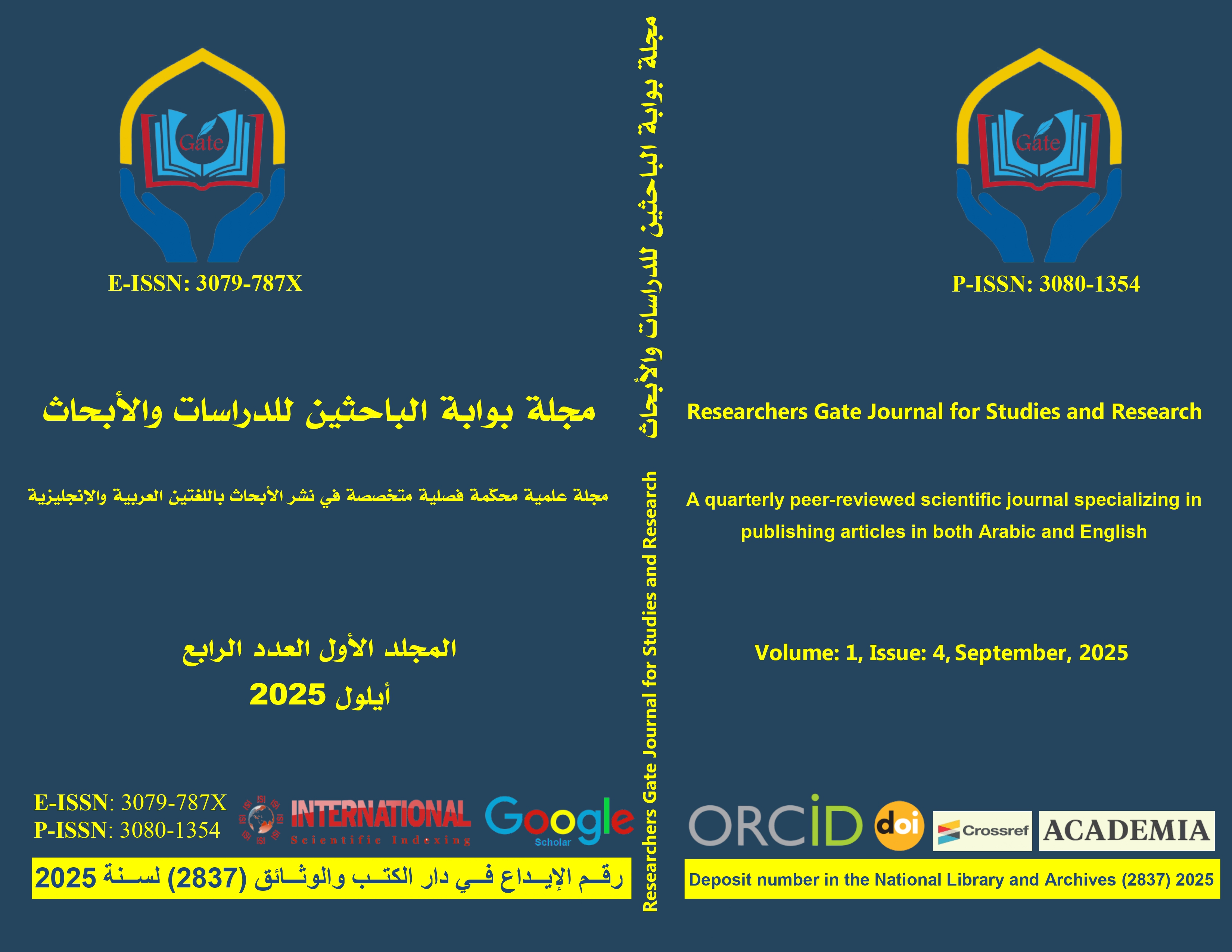التدريس من قِبل الأقران كمُيسِّر للوصول للمتعلمين المتقدمين
DOI:
https://doi.org/10.64337/rgj.v1i4.144الكلمات المفتاحية:
التدريس بين الأقران، آليات، تدريب، مدرسون أقران، أداء أكاديمي.الملخص
تهدف هذه الدراسة إلى استقصاء فعالية التدريس بين الأقران (peer tutoring) في تعزيز مجالات التعلم المختلفة لدى طلاب الجامعات في المرحلتين الجامعية والدراسات العليا. تركز الدراسة على استكشاف الآثار المعرفية والأكاديمية والاجتماعية-العاطفية للتدريس بين الأقران، كما تحدد بعض التحديات التي تواجه تطبيقه.
اعتمدت الدراسة على استبيانات وُزعت على 30 مُدرّساً و50 طالباً متقدماً من المدرسين الأقران. أظهرت النتائج أن غالبية المدرسين والطلاب (80% من المستجيبين) ينظرون إلى التدريس بين الأقران كأداة فعّالة لا تقتصر فوائدها على تحسين أداء الطلاب المُتلقين فحسب، بل تمتد لتشمل المدرسين الأقران من حيث تعميق فهمهم للمادة وتعزيز مهاراتهم القيادية.
على الرغم من ذلك، كشفت الدراسة عن تحديات مثل محدودية وقت الإعداد، والتأثير السلبي المحتمل على درجات المدرسين الأقران، ونقص آليات الدعم الواضحة. وبناءً على هذه النتائج، توصي الدراسة بأهمية دمج التدريس بين الأقران في المناهج الدراسية مع توفير تدريب مكثف للمدرسين الأقران وتوفير آليات دعم مؤسسي لضمان استدامة وفعالية هذه البرامج.
المراجع
1. Chan, L. K. S., & Lai, P. Y. (2007). Enhancing metacognitive skills through peer tutoring. Instructional Science, 35(3), 205–225. https://doi.org/10.1007/s11251-006-9015-7
2. King, A. (1998). Transactive peer tutoring: Distributing cognition and metacognition. Educational Psychology Review, 10(1), 57–74. https://doi.org/10.1023/A:1022622422067 DOI: https://doi.org/10.1023/A:1022858115001
3. Landrum, T. J., & McDuffie, K. A. (2010). Learning styles in the age of differentiated instruction. Exceptionality, 18(1), 6–17. https://doi.org/10.1080/09362830903462441 DOI: https://doi.org/10.1080/09362830903462441
4. L Peer, M. (2018). Peer tutoring and its impact on advanced learners: A review of the literature. Journal of Advanced Education, 45(2), 115–130.
5. Lubienski, S. T. (2002). Research, reform, and equity in U.S. mathematics education. Mathematical Thinking and Learning, 4(2–3), 103–125. https://doi.org/10.1207/S15327833MTL04023_2 DOI: https://doi.org/10.1207/S15327833MTL04023_2
6. Mastropieri, M. A., Scruggs, T. E., & Berkeley, S. (2007). Peers helping peers: Promoting learning through peer tutoring. Intervention in School and Clinic, 43(1), 13–20. https://doi.org/10.1177/10534512070430010301 DOI: https://doi.org/10.1177/10534512070430010301
7. McMaster, K. L., Fuchs, D., & Fuchs, L. S. (2006). Research on peer-assisted learning strategies: The promise and limitations. Reading & Writing Quarterly, 22(1), 5–25. https://doi.org/10.1080/10573560500203491 DOI: https://doi.org/10.1080/10573560500203491
8. Miller, R., & Hudson, P. (2007). Using peer tutoring in inclusive classrooms. Preventing School Failure, 51(4), 19–26. https://doi.org/10.3200/PSFL.51.4.19-26 DOI: https://doi.org/10.3200/PSFL.51.2.19-22
9. O'Donnell, A. M. (2006). The role of peers and group learning. In P. A. Alexander & P. H. Winne (Eds.), Handbook of educational psychology (2nd ed., pp. 781–802). Lawrence Erlbaum Associates.
10. Pomerantz, E. M., & Eaton, M. M. (2001). Maternal intrusive support in the academic context: Transactional socialization processes. Developmental Psychology, 37(2), 174–186. https://doi.org/10.1037/0012-1649.37.2.174 DOI: https://doi.org/10.1037//0012-1649.37.2.174
11. Reis, S. M., & Renzulli, J. S. (2010). Is there still a need for gifted education? An examination of current research. Learning and Individual Differences, 20(4), 308–317. https://doi.org/10.1016/j.lindif.2009.10.012 DOI: https://doi.org/10.1016/j.lindif.2009.10.012
12. Robinson, A., Shore, B. M., & Enersen, D. L. (2006). Best practices in gifted education: An evidence-based guide. Prufrock Press.
13. Rohrbeck, C. A., Ginsburg-Block, M. D., Fantuzzo, J. W., & Miller, T. R. (2003). Peer-assisted learning interventions with elementary school students: A meta-analytic review. Journal of Educational Psychology, 95(2), 240–257. https://doi.org/10.1037/0022-0663.95.2.240 DOI: https://doi.org/10.1037/0022-0663.95.2.240
14. Roseth, C. J., Johnson, D. W., & Johnson, R. T. (2008). Promoting early adolescents' achievement and peer relationships: The effects of cooperative, competitive, and individualistic goal structures. Psychological Bulletin, 134(2), 223–246. https://doi.org/10.1037/0033-2909.134.2.223 DOI: https://doi.org/10.1037/0033-2909.134.2.223
15. Topping, K. J. (1996). The effectiveness of peer tutoring in further and higher education: A typology and review of the literature. Higher Education, 32(3), 321–345. https://doi.org/10.1007/BF00138870 DOI: https://doi.org/10.1007/BF00138870
16. Topping, K. J. (2005). Trends in peer learning. Educational Psychology, 25(6), 631–645. https://doi.org/10.1080/01443410500345172 DOI: https://doi.org/10.1080/01443410500345172
17. Topping, K. J., & Ehly, S. W. (2001). Peer assisted learning: A framework for consultation. Journal of Educational and Psychological Consultation, 12(2), 113–132. https://doi.org/10.1207/S1532768XJEPC1202_03 DOI: https://doi.org/10.1207/S1532768XJEPC1202_03
18. VanTassel-Baska, J. (2003). Content-based curriculum for high-ability learners. Prufrock Press.
19. VanTassel-Baska, J., & Stambaugh, T. (2006). Comprehensive curriculum for gifted learners (3rd ed.). Allyn & Bacon.
20. Zimmerman, B. J., & Schunk, D. H. (Eds.). (2001). Self-regulated learning and academic achievement: Theoretical perspectives (2nd ed.). Lawrence Erlbaum Associates.
التنزيلات
منشور
كيفية الاقتباس
إصدار
القسم
الرخصة
الحقوق الفكرية (c) 2025 Habbar Hussein Jasim

هذا العمل مرخص بموجب Creative Commons Attribution 4.0 International License.















